Resurrection of the “Holey”
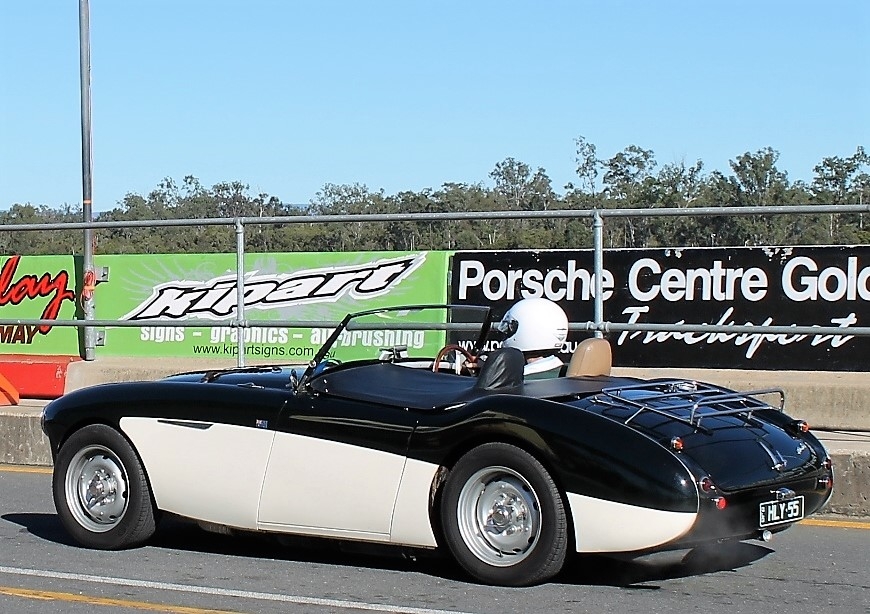
Austin Healey 100 chassis no. BN1-223926 rolled out of the Longbridge factory on 10 February 1955 (two weeks after BN1-222490, which later became the Ward Special). The car was Healey blue with blue trim, and was dispatched to UK Motors in Brisbane. Fast forward to some time in the mid-1980s, when Bob Whittred came across the remains of the car in a paddock near Ballina NSW, where it had sat for many years following an apparently fatal accident in which the front left corner was extensively damaged. The drive train and most of the running gear were long gone, and most of us if we'd seen it (including me) would have dismissed it as a lost cause. Not Bob though, who had already restored another Hundred (black over silver) and a BJ8, green, now owned by Owen Williamson.
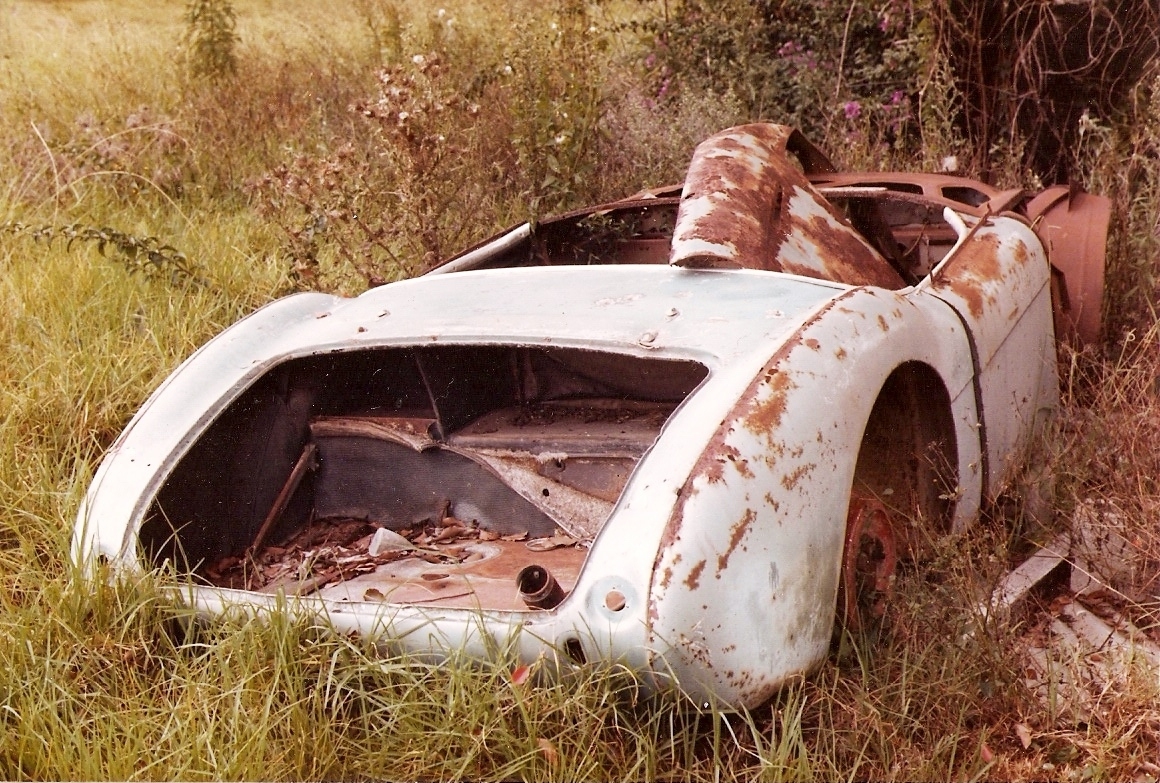
Bob paid $450.00 for the sad remains, and commenced what by any standards was a mammoth task of restoration. This involved replacing the front half of the chassis rails, cross members, much of the body sub-frame and repair or replacement of most of the outer body panels. BN2 rear guards were fitted, and the car got to the stage where it was ready for final panel work and paint.
On the mechanical side, Bob used Wolseley 6/110 front suspension including disc brakes with booster, and rear axle with 3.54 diff. Engine wise, Bob planned at first to use a Rover 3.5 litre V8, but found this a tight fit, so instead sourced a 40,000km V6 from a Lexcen (Series1 VN Commodore) This came with a 4 speed auto (!) gearbox. The motor was a good fit though, smaller, lighter, lower and further back in the chassis than the original – and with 165 bhp in standard tune!
The restoration stalled in the mid-'90s, and some 15 years later decided that the car would have to go. I first heard of it via Alwyn Keepence, and like most people turned my nose up at the idea of a foreign engine and, even worse, an auto gearbox. I'd been looking for a standard-bodied 100 project as, much as I like the Ward Special, I wanted to get back to open air motoring for the first time in nearly 30 years. I last drove my MGTD before leaving the UK in 1982. I'd looked at a couple of other projects (one since bought by Bob Pierce) but for various reasons the deals didn't go through, so I thought again about Bob's car.
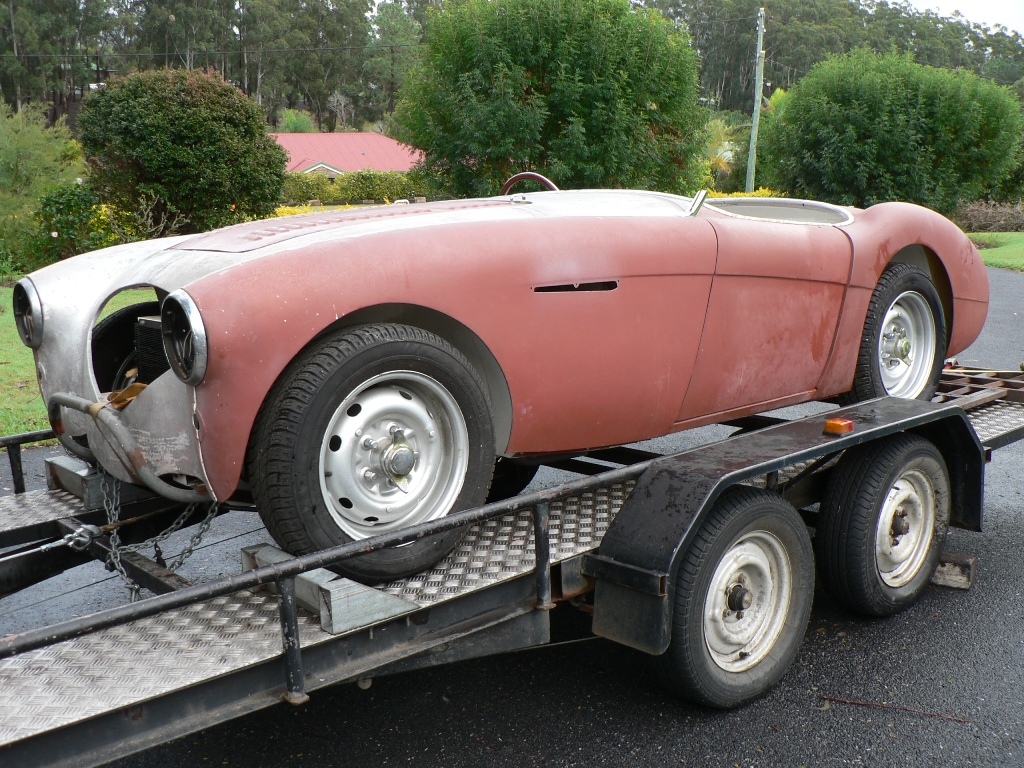
It appealed to me as soon as I saw it – complete, straight and with many new parts. I particularly liked the wheels Bob had made – 100/6 steel centres with Dodge or Chrysler rims, different offsets front and rear, and with knock on spinners in the middle (non-functional, but giving the appearance of Dunlop peg drive alloys like those worn by the Bonneville record breakers). Bob had also made a very nice wood-rim steering wheel using the original centre and spokes. After not very much thought and a fairly brief discussion over price (we both had the same figure in mind) The car was mine, and arrived at Rivergum Drive on a trailer in July 2008.
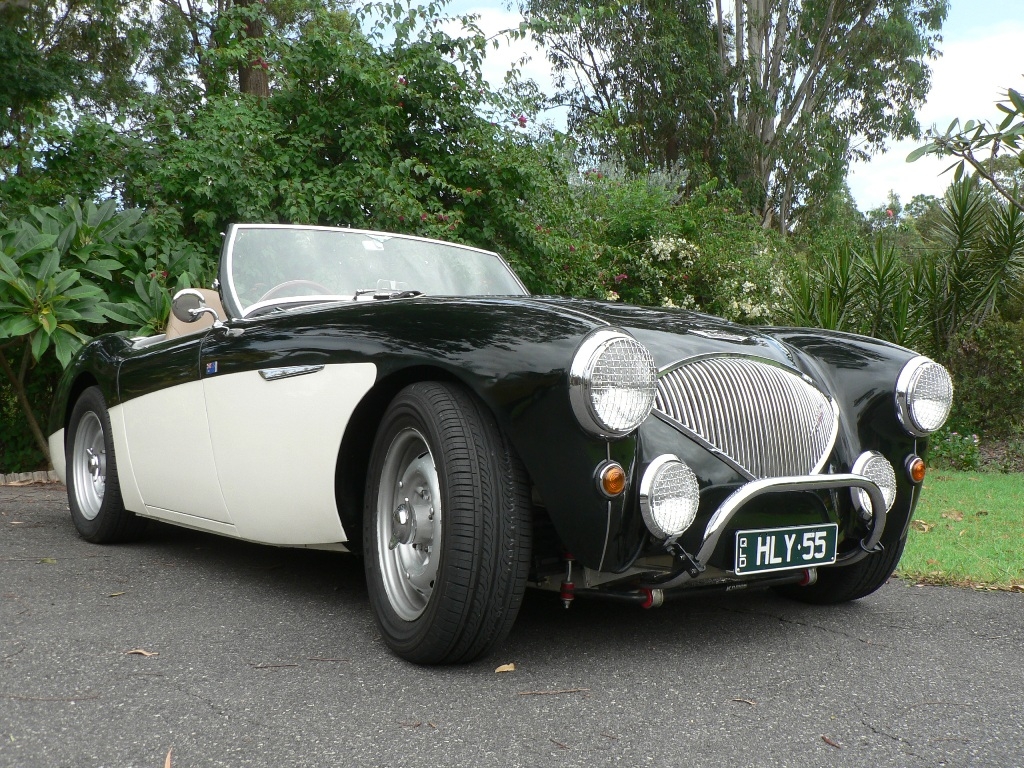
As I was part way through restoring a 1963 Series 2A Landrover, the sale of which would kick start the Healey's completion, I didn't start work seriously until well into 2009. I did apply for the Heritage certificate though, using the body number as the chassis plate had gone. This turned up the car's identity as BN1-223926, and that it had been delivered originally to UK Motors Brisbane. I also had a look (not very hopefully!) at the Personalised Plates Queensland site to see if anything suitable was available. To my amazement, HLY 55 was still there, so I snapped it up, in white letters on a dark green background, as my intention was to paint the car dark BRG over Old English White. Bob had planned to paint it in 100S colours of OEW over Lobelia blue, hence the white chassis.
Another early task was to get a Queensland Transport approved compliance engineer to look at the car to make sure I could proceed with it in view of the modifications. Earl Gilchrist of Autotechnica Cleveland came out and checked the car over. He gave me a list of upgrades that would be required in order for it to be approved with the replacement motor. These included dual circuit brakes, two speed wipers, a demister and retractable seat belts. One item that could have buried the project was that a collapsible steering column is required if the replacement engine is more than 45% bigger in capacity than the original. This looked likely on the rounded figures for the two motors, but using the exact figures from the factory specifications, it came out to 42.5%. Phew!
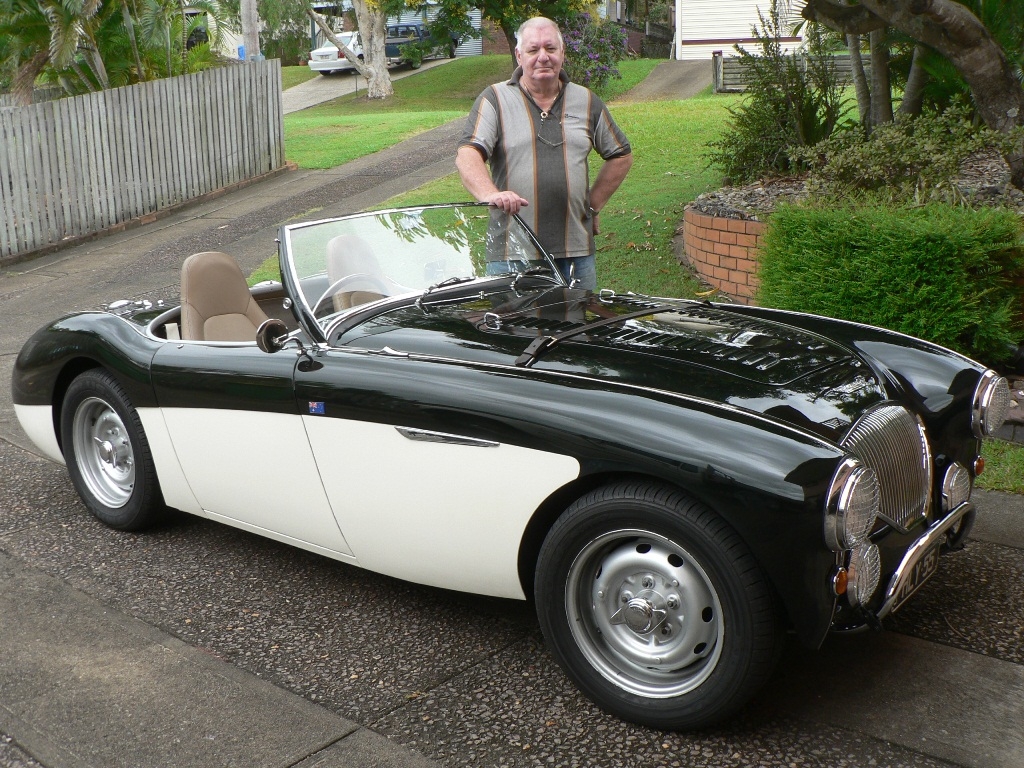
At this point I started looking at finishing off the mechanical side of things. This included the cooling system and the brakes, including separating the front and rear circuits.(I used a Datsun 240Z master cylinder courtesy of George Goss, with the PBR booster operating on the front only) I had to make up brackets for the front hoses, for which I used Range Rover parts. There was no handbrake lever, so I borrowed the one from the above mentioned Landrover which is very similar in appearance to the Healey one, once chromed.
My Series 3 Landrover donated its two speed wiper motor, and a 12 volt camping hairdryer became the demister! Hardy Spicer made a tailshaft using the Healey rear and Holden front yokes, with larger diameter tube. I had all the brake components checked over and refurbished as necessary by Stopmasters and Stainless Steel Resleevers, both at Brendale.
Bob had fabricated a very nice 85 litre alloy fuel tank, but had not had it welded together, so I had it TIG welded. He also had a nice Aston type quick release filler cap, which he had intended to use in the normal place inside the boot. I though it was a shame to hide it, so rearranged things so that the filler was on the rear shroud.
The fuel system uses the Holden in-tank pump and out and back fuel lines for the injection system. I did consider looking for a 5 speed manual transmission, but on second thoughts decided against, as Veronica can only drive an auto and I can only drive one car at a time! Instead I modified the Holden shifter to disguise it as best I could, and mounted it direct to the transmission. Rod Shepherd provided a fibreglass centre shift tunnel cover (Ex-Alwyn Keepence!) which I modified to suit.
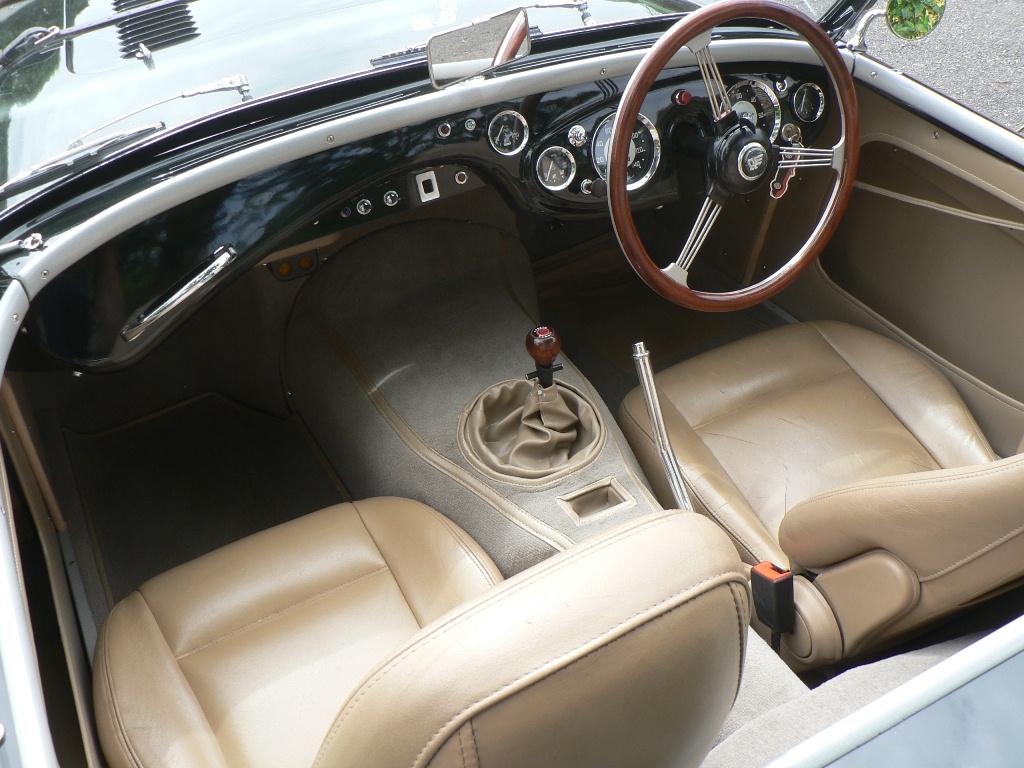
Restored Interior
The one thing I wasn't keen on that Bob had done was the wooden dash incorporating the Lexcen instrument panel. Bob had though this would make it easier to wire the computer-driven motor, but discussions with V6 Conversions in Moree and Lionel Otto Instruments suggested that original appearance gauges could be used. Bob had provided an original dash panel, a speedo (gold faced), a fuel gauge and a 33/8 VDO tacho.
I already had a temperature gauge and oil pressure gauge (bought for $2.00 each at Toowoomba Swap!) I took all this to Lionel Otto's who put a black 140mph face in the speedo and rebuilt the fuel and temperature gauges. It turned out that the VDO tacho wouldn't work with electronic ignition, so Otto's built an electronic tacho from parts they had in stock. The result is an original-looking set of instruments, except for separate oil pressure and temperature gauges. V6 conversions proved very useful, also supplying a cable drive adaptor for the speedo, and an idler pulley to replace the power steering pump.
It was now (October 2009) getting close to the point where the motor could be reawakened. This meant wiring, which was beyond my rudimentary electrical abilities. The ECU and main engine compartment loom were in place, as was the loom to the rear of the car, but the rest need doing. I obtained a Holden relay box and fuse panel from the local wreckers, then the car went to Bashi's Auto Electrics at Caboolture. Gezim, Troy and co did a great job and a week or so later it was a case of 'it's alive!' It was a great feeling to drive the car off the trailer and up the driveway (and down, and up again!) for the first time. It was now time to think about painting.
I'd already lined up with Peter Janetzki to do the final panel and paint work, and my son in law was able to obtain paint at a very reasonable price. The colours are 1950s Jaguar BRG (very dark) and OEW. Peter did an excellent job and I have to say that the result exceeded my expectations. I could now assemble the chromework etc, most of which was new and came with the car. There are no bumpers which I prefer, except for a small nudge bar at the front that Bob had made, and I had chromed. Bob had also cast some brass 3000 badges, one of which I modified to read 3800 and had chromed for the grille. I bought a nice pair of Hella spotlights on Ebay, where I also found some rear indicator units to fit the reflector pods. I have amber indicators at the front too in place of the side lights, which are now in the headlamp units. The local saddlery provided the bonnet strap and spare wheel retaining strap (the spare wheel sits on top of the fuel tank).
On advice from Dave Railton, I bought a pair of Mazda MX5 seats, which fit well and are fully adjustable, even if the high backs don't look quite right! I managed to find vinyl to match the biscuit colour of the seats, and a stone coloured carpet. Bob had already made door and footwell trim panels, so it was a matter of covering these and fitting carpets. I Blanked off the spare wheel slot from the boot and covered the area behind the seats in carpet. I did all the easy bits of trimming myself, and Alwyn's brother Andrew of Retro Recovery did a great job of the difficult bits, especially the tunnel cover.
So now it was crunch time, back to the compliance engineer to see if that blue plate was forthcoming. Autotechinca is at Cleveland, so this was the car's first road outing of any length. I was amazed at how together it seemed straight out of the box. It handled beautifully (it has telescopic shocks all round and  deg negative camber on the front) Although the Michelin 185/65-15 MXT tyres originally on the car were unused, they were 16 years old so I had replaced them with similar section Kumhos. The car had shown signs of overheating on previous short trips, but reversing the direction of the thermo fan (it was blowing the wrong way!) and replacing the thermostat seemed to have cured this.
However, the car started overheating again during brake testing, and also began cutting out. I got half way home before it cut out altogether, and we made the rest of the trip on a tilt tray! However, there was little I had to do to satisfy the compliance engineer, and after finding a bit extra ground clearance under the exhaust, fitting bigger reinforcement plates under seats and seat belts, getting the speedo recalibrated and installing a shift indicator (courtesy of a hot rod supplier!) I had that blue plate. The safety certificate inspection was uneventful, and on the 16th March 2010, the car was on the road for the first time in, probably, 40 years!
I've since replaced the 12″ thermo fan with a 16″ one, which has resolved the overheating problem, but the cutting out when hot issue still remained, due probably to a faulty crank angle sensor, which has now been replaced. The problem occurred once on the way to the David Hack Classic in Toowoomba, and it seems that cavitation of fuel when hot may be the cause. Next on the 'To do' list is a tonneau cover, followed by refurbishment of the fibreglass hardtop that came with the car. I have the rusty remains of hood bows plus some other hood frame components, but I haven't yet decided if I'll try fitting a soft top.
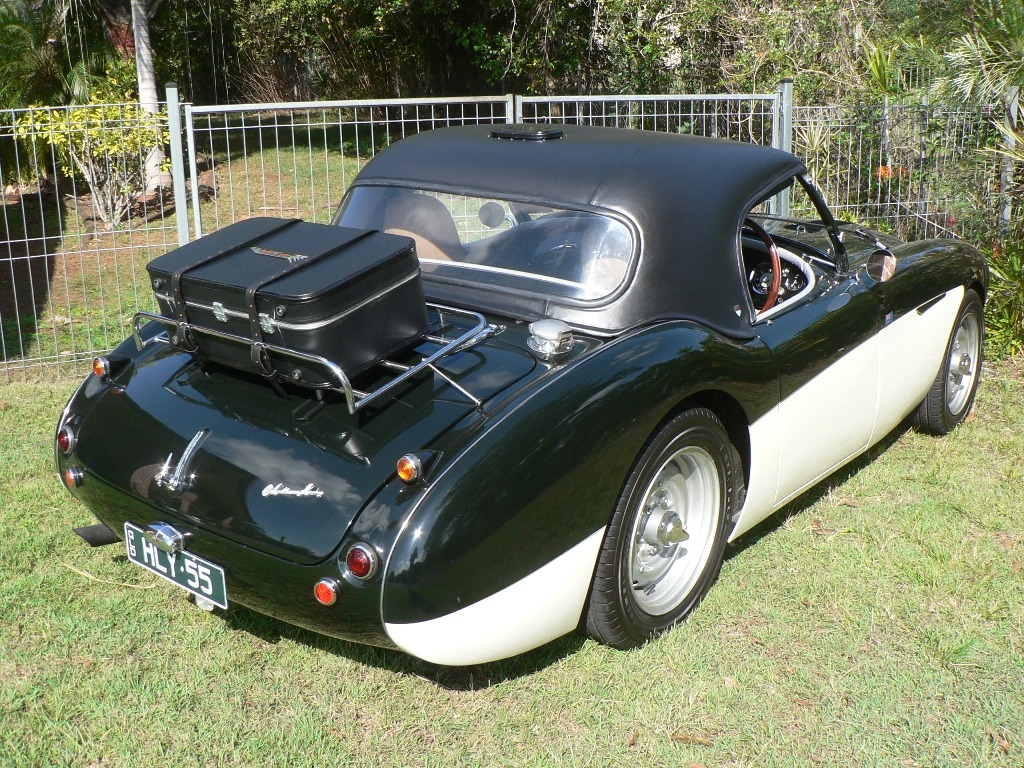
So: original – no; practical – yes. And in keeping with what DMH would approve of? I think so. After all, they tried the Rolls Royce motor in the 4000 prototypes, at least one of which had an auto gearbox. And if the V6 or a similar motor had been available when the A90 unit was going out of production, would DMH have used it? Minimal chassis modifications needed, nearly twice the power, smaller, lighter, making a better balanced car? I think I know the answer.
Peter Linn
Related pages



